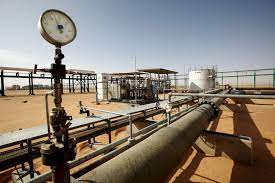
Libya's Oil Revenue Slides to $7 Billion in First Half of 2023
Posted 11/07/2023 12:09
Libya's oil revenue, excluding royalties and fuel sales, declined to approximately $7 billion (LYD 33.4 billion) in the first half of 2023 compared to the same period last year, according to official data. The North African country, known for its significant oil reserves, collected nearly $8 billion (LYD 37.3 billion) in oil revenue in the previous year's corresponding period. The closure of the Mellitah oil and gas complex by the National Oil Corp. (NOC) in May temporarily impacted production. However, the facility resumed operations after renovations were completed. The startup of the Erawen oil field and the Ras Lanuf industrial complex provided a boost to Libyan fossil fuel production.
Despite the decline in oil revenue, the Central Bank of Libya reported an increase in oil royalties between May and June 2023, contributing to total revenues of over $10 billion (LYD 49.5 billion) in the review period. Oil accounted for approximately 78.5 percent of Libya's total public revenue in the previous year, highlighting its significance to the country's economy. The NOC has plans to further expand production and aims to raise output to two million barrels per day.
In early 2023, the NOC and Eni signed a deal to invest approximately $8 billion into a project aimed at increasing gas production for domestic use and exports to Europe. The project, scheduled to be operational by 2026, will significantly contribute to Libya's gas production capacity. Additionally, the NOC signed an agreement with Honeywell UOP for the front-end engineering design of the South Refinery, which is expected to start operating within 36 months.
Furthermore, an oil discovery was announced in the Ghadames basin on Block 4, marking the third discovery in Contract Area 82. The flow rate from the exploration well is reported to be 1,870 barrels of oil per day.
Despite fluctuations in oil revenue, Libya remains committed to developing its energy sector and maximizing its production capabilities.
Libya's oil revenue, excluding royalties and fuel sales, declined to approximately $7 billion (LYD 33.4 billion) in the first half of 2023 compared to the same period last year, according to official data. The North African country, known for its significant oil reserves, collected nearly $8 billion (LYD 37.3 billion) in oil revenue in the previous year's corresponding period. The closure of the Mellitah oil and gas complex by the National Oil Corp. (NOC) in May temporarily impacted production. However, the facility resumed operations after renovations were completed. The startup of the Erawen oil field and the Ras Lanuf industrial complex provided a boost to Libyan fossil fuel production.
Despite the decline in oil revenue, the Central Bank of Libya reported an increase in oil royalties between May and June 2023, contributing to total revenues of over $10 billion (LYD 49.5 billion) in the review period. Oil accounted for approximately 78.5 percent of Libya's total public revenue in the previous year, highlighting its significance to the country's economy. The NOC has plans to further expand production and aims to raise output to two million barrels per day.
In early 2023, the NOC and Eni signed a deal to invest approximately $8 billion into a project aimed at increasing gas production for domestic use and exports to Europe. The project, scheduled to be operational by 2026, will significantly contribute to Libya's gas production capacity. Additionally, the NOC signed an agreement with Honeywell UOP for the front-end engineering design of the South Refinery, which is expected to start operating within 36 months.
Furthermore, an oil discovery was announced in the Ghadames basin on Block 4, marking the third discovery in Contract Area 82. The flow rate from the exploration well is reported to be 1,870 barrels of oil per day.
Despite fluctuations in oil revenue, Libya remains committed to developing its energy sector and maximizing its production capabilities.








